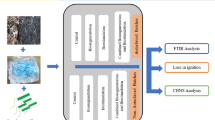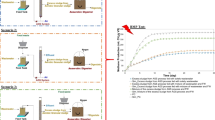Abstract
Treatment of an oil-rich sludge from an oil field in southern coastal areas of Iran with an initial total petroleum hydrocarbon (TPH) content of 38,000 mg/kg through composting technology was evaluated, and the effects of re-inoculation using halophile bacteria, mixing ratio, and surfactant application on TPH removal were studied. Results indicated that biosurfactant addition and re-inoculation enhanced the process efficiency, and a TPH removal of 81.7% was observed in selected conditions. Furthermore, mixing ratios of oily sludge and matured compost were critical factors in improving TPH removal. The highest removal rate of 0.91% was seen in the oily sludge/finished compost ratio of 0.5. Pseudo-first-order kinetic model was better fitted with experimental results, and a reaction rate constant of 0.245 week−1 was calculated. Also, the final product qualified the standards of heavy metal content based on the US environmental protection agency recommendation. According to the results obtained, it can be said that composting technology supported by inoculation with halophile bacterial consortium and biosurfactant addition and re-inoculation can be effective in treating oily wastes containing various hydrocarbons. Considering the obtained results, it can be declared that composting can lead to promising results in treating oily wastes containing a variety of hydrocarbons.










Similar content being viewed by others
Data availability
Not applicable.
Code availability
Not applicable.
References
Lodungi J, Alfred D, Khirulthzam A, Adnan F, Tellichandran S (2016) A Review in oil exploration and production waste discharges according to legislative and waste management practices perspective in Malaysia. Int J Waste Resour 7(260):2
Anisimov A, Frolov V, Ivanov E, Karakhanov E, Lesin S, Vinokurov V (2018) Complex technology of oil sludge processing, Scientific-Practical Conference Research and Development-2016, 617.
Johnson OA, Affam AC, Johnson OA, Affam AC (2018) Petroleum sludge treatment and disposal: a review. Environ Eng Res 24(2):191–201
Geraci M, Ali SJ, Romolt C, Rossmann R (2017) The environmental risks and oversight of enhanced oil recovery in the United States
Sharuddin S, Sheikh Abdullah SR, AbuHasan H, RaziOthman A, IzzatiIsmail N (2021) Potential bifunctional rhizobacteria from crude oil sludge for hydrocarbon degradation and biosurfactant production. Pro Safety Environ Protection 155:108-121.
Nwankwegu A, Zhang L, Xie D, Onwosi C, Muhammad W, Odoh C, Sam K, Idenyi J (2022) Bioaugmentation as a green technology for hydrocarbon pollution remediation Problems and prospects. J Environ Manage 304:114313
Kaczorek E, Pacholak A, Zdarta A, Smułek W (2018) The impact of biosurfactants on microbial cell properties leading to hydrocarbon bioavailability increase. Colloids and Interfaces 2(3):35
Tekere M (2019) Microbial bioremediation and different bioreactors designs applied, Biotechnology and Bioengineering, IntechOpen
Aguelmous A, El Fels L, Souabi S, Zamama M, Lahsaini S, Lebrihi A, Bekkaoui F, Hafidi M (2020) Humification process and total petroleum hydrocarbons assessment during oily sludge composting, Waste and Biomass Valorization, 1–11.
Xu X, Liu W, Tian S, Wang W, Qi Q, Jiang P, Gao X, Li F, Li H, Yu H (2018) Petroleum hydrocarbon-degrading bacteria for the remediation of oil pollution under aerobic conditions: a perspective analysis. Front Microbiol 9:2885
M. Ahmadi, S. Jorfi, R. Kujlu, S. Ghafari, R. Darvishi Cheshmeh Soltani, N. Jaafarzadeh Haghighifard, A novel salt-tolerant bacterial consortium for biodegradation of saline and recalcitrant petrochemical wastewater. J Environ Manage 191 (2017) 198–208.
Pourfadakaria S, Ahmadi M, Jaafarzadeh N, Takdastan A, Neisi A, Ghafari S, Jorfi S (2019) Remediation of PAHs contaminated soil using a sequence of soil washing with biosurfactant produced by Pseudomonas aeruginosa strain PF2 and electrokinetic oxidation of desorbed solution, effect of electrode modification with Fe3O4 nanoparticles. J Haz Mater 379:120839
Pourfadakari S, Jorfi S, Ghafari S (2020) An efficient biosurfactant by Pseudomonas stutzeri Z12 isolated from an extreme environment for remediation of soil contaminated with hydrocarbons. Chem Biochem Eng Q 34:35–48
Feizi R, Jorfi S, Takdastan A (2020) Bioremediation of phenanthrene-polluted soil using Bacillus kochii AHV-KH14 as a halo-tolerant strain isolated from compost, Environ Health. Eng Manage J 7:23–30
Ahmadi M, Niazi F, Jaafarzadeh N, Ghafari S, Jorfi S (2021) Characterization of the biosurfactant produced by Pseudomonas aeruginosa strain R4 and its application for remediation pyrene-contaminated soils. J Environ Health Sci Eng 19:445–456. https://doi.org/10.1007/s40201-021-00617-
Koolivand A, Abtahi H, Godini K, Saeedi R, Rajaei MS, Parhamfar M (2019) Biodegradation of oil tank bottom sludge using a new two-phase composting process: kinetics and effect of different bulking agents. J Mater Cycles Waste Manage 21(6):1280–1290
Parhamfar M, Abtahi H, Godini K, Saeedi R, Sartaj M, Villaseñor J, Coulon F, Kumar V, Soltanighias T, Ghaznavi-Rad E (2019) Biodegradation of heavy oily sludge by a two-step inoculation composting process using synergistic effect of indigenous isolated bacteria, Process Biochem.
Hisham MB, Hanisah N, Ibrahim MF, Ramli N, Abd-Aziz S (2019) Production of biosurfactant produced from used cooking oil by Bacillus sp. HIP3 for heavy metals removal. Molecules 24(14):2617
Jorfi S, Rezaee A, Mobeh-Ali G-A, Jaafarzadeh NA (2013) Application of biosurfactants produced by Pseudomonas aeruginosa SP4 for bioremediation of soils contaminated by pyrene. Soil Sediment Contam 22(8):890–911
Neisi A, Rahmani AR, Ghafari S, Jorfi S, Almasi H (2020) Biodegradation of Bisphenol A in a saline industrial wastewater using Alcaligenes faecalis strain BPAN5. Desalin Water Treat 189:276–282
Sbani N, SheikhAbdullah S, Idris M, Abu Hasan H, EffendiHalmi M, Jehawi O, Ismail N (2021) PAH-degrading rhizobacteria of Lepironia articulata for phytoremediation enhancement. J Wat Pro Eng 39:101688
Nwankwegu A, Li Y, Jiang L, Lai Q, Shenglin W, Jin W, Acharya K (2020) Kinetic modelling of total petroleum hydrocarbon in spent lubricating petroleum oil impacted soil under different treatments. Environ Technol 41:339–348. https://doi.org/10.1080/09593330.2018.1498543
ISO (2007) Water quality–test for inhibition of oxygen consumption by activated sludge for carbonaceous and ammonium oxidation, International Organization for Standardization Geneva.
Le Bail J, Laroche T, Marre-Fournier F, Habrioux G (1998) Aromatase and 17β-hydroxysteroid dehydrogenase inhibition by flavonoids. Cancer Lett 133(1):101–106
ISO (1999) Water quality–test for inhibition of oxygen consumption by activated sludge for carbonaceous and ammonium oxidation., International Organization for Standardization (15522), Geneva, p. 12.
U.C. Council (2002) The test method for the examination of composting and compost (TMECC), US Composting Council, Bethesda, MD.
Tuomi T, Veijalainen H, Santonen T (2018) Managing exposure to benzene and total petroleum hydrocarbons at two oil refineries 1977–2014. Int J Environ Res Public Health 15(2):197
Gholami-Shiri J, Mowla D, Dehghani S, Setoodeh P (2017) Exploitation of novel synthetic bacterial consortia for biodegradation of oily-sludge TPH of Iran gas and oil refineries. J Environ Chem Eng 5(3):2964–2975
You Z, Xu H, Zhang S, Kim H, Chiang P-C, Yun W, Zhang L, He M (2018) Comparison of petroleum hydrocarbons degradation by Klebsiella pneumoniae and Pseudomonas aeruginosa. Appl Sci 8(12):2551
Santisi S, Cappello S, Catalfamo M, Mancini G, Hassanshahian M, Genovese L, Giuliano L, Yakimov MM (2015) Biodegradation of crude oil by individual bacterial strains and a mixed bacterial consortium. Braz J Microbiol 46(2):377–387
Agrawal N, Shahi SK (2015) An environmental cleanup strategy-microbial transformation of xenobiotic compounds. Int J Curr Microbiol App Sci 4(4):429–461
Beddow J, Stölpe B, Cole PA, Lead JR, Sapp M, Lyons BP, McKew B, Steinke M, Benyahia F, Colbeck I (2014) Estuarine sediment hydrocarbon-degrading microbial communities demonstrate resilience to nanosilver. Int Biodeterior Biodegradation 96:206–215
Beck AE, Hunt KA, Carlson RP (2018) Measuring cellular biomass composition for computational biology applications. Processes 6(5):38
Klimek B, Sitarz A, Choczyński M, Niklińska M (2016) The effects of heavy metals and total petroleum hydrocarbons on soil bacterial activity and functional diversity in the Upper Silesia industrial region (Poland), Water, Air, & Soil Pollution 227(8):265.
Assaha DV, Ueda A, Saneoka H, Al-Yahyai R, Yaish MW (2017) The role of Na+ and K+ transporters in salt stress adaptation in glycophytes. Front Physiol 8:509
Sharuddin S, Sheikh Abdullah S, Abu Hasan H, Othman A, Ismail N (2021) Potential bifunctional rhizobacteria from crude oil sludge for hydrocarbon degradation and biosurfactant production, Process Safe Environ Prot, 155:108–121.
Marchut-Mikolajczyk O, Drożdżyński P, Pietrzyk D, Antczak T (2018) Biosurfactant production and hydrocarbon degradation activity of endophytic bacteria isolated from Chelidonium majus L. Microb Cell Fact 17(1):1–9
Zhang D, Zhu L (2012) Effects of Tween 80 on the removal, sorption and biodegradation of pyrene by Klebsiella oxytoca PYR-1. Environ Pollut 164:169–174
Varjani SJ, Upasani VN (2017) A new look on factors affecting microbial degradation of petroleum hydrocarbon pollutants. Int Biodeterior Biodegradation 120:71–83
Roy A, Dutta A, Pal S, Gupta A, Sarkar J, Chatterjee A, Saha A, Sarkar P, Sar P, Kazy SK (2018) Biostimulation and bioaugmentation of native microbial community accelerated bioremediation of oil refinery sludge. Biores Technol 253:22–32
Nwankwegu AS, Orji MU, Onwosi CO (2016) Studies on organic and in-organic biostimulants in bioremediation of diesel-contaminated arable soil. Chemosphere 162:148–156
Koolivand A, Naddafi K, Nabizadeh R, Nasseri S, Jafari AJ, Yunesian M, Yaghmaeian K, Nazmara S (2013) Biodegradation of petroleum hydrocarbons of bottom sludge from crude oil storage tanks by in-vessel composting. Toxicol Environ Chem 95(1):101–109
Wang S-Y, Kuo Y-C, Hong A, Chang Y-M, Kao C-M (2016) Bioremediation of diesel and lubricant oil-contaminated soils using enhanced landfarming system. Chemosphere 164:558–567
Gomez F, Sartaj M (2013) Field scale ex-situ bioremediation of petroleum contaminated soil under cold climate conditions. Int Biodeterior Biodegradation 85:375–382
Mirghaffari N (2017) Treatment and recycling of oily sludges produced in the petroleum industry, 2017 International Conference on Environmental Impacts of the Oil and Gas Industries: Kurdistan Region of Iraq as a Case Study (EIOGI), IEEE, pp. 1–2.
RezaAsgari A, Nabizadeh R, HosseinMahvi A, Dehghani MH, Yaghmaeian K (2018) Monitoring of element changes during in-vessel composting for removal of total petroleum hydrocarbons from oily acidic sludge, Health Scope 7(4).
Singh WR, Pankaj SK, Kalamdhad AS (2015) Reduction of bioavailability and leachability of heavy metals during agitated pile composting of Salvinia natans weed of Loktak Lake. Int J Recycl Org Waste Agric 4(2):143–156
Samaei MR, Jalili M, Abbasi F, Mortazavi SB, JonidiJafari A, Bakhshi B (2020) Isolation and kinetic modeling of new culture from compost with high capability of degrading n-hexadecane, focused on Ochrobactrum oryzae and Paenibacillus lautus. Soil Sediment Contam 29(4):384–396
Liang J, Ning X-A, Sun J, Song J, Lu J, Cai H, Hong Y (2018) Toxicity evaluation of textile dyeing effluent and its possible relationship with chemical oxygen demand. Ecotoxicol Environ Saf 166:56–62
Ra J-S, Jeong T-Y, Lee S-H, Kim SD (2016) Application of toxicity identification evaluation procedure to toxic industrial effluent in South Korea. Chemosphere 143:71–77
Ortiz R, Stuckey DC, Steele TW (2019) Rapid EC50 determination of hydrophobic toxicants in continuous droplet biomicrofluidics, Micro and Nano. Engineering 3:82–91
Guerin TF (2021) Prototyping of co-composting as a cost-effective treatment option for full-scale on-site remediation at a decommissioned refinery, J Clean Product 302:127012
Funding
The present research funding has been provided by the Environmental Technologies Research Center, Ahvaz Jundishapur University of Medical Sciences (Grant No. U-98109).
Author information
Authors and Affiliations
Contributions
Reza Saeedi: conceptualization, methodology, investigation, resources, writing—original draft.
Mehrnoosh Abtahi: conceptualization, methodology, resources, investigation, supervision, acquisition.
Halime Almasi: review and editing validation, formal analysis.
Sahand Jorfi: conceptualization, methodology, investigation, writing—original draft.
Corresponding author
Ethics declarations
Ethics approval
IR.AJUMS.REC.1398.432
Consent to participate
Not applicable.
Consent for publication
Not applicable.
Competing interests
The authors declare no competing interests.
Additional information
Publisher’s note
Springer Nature remains neutral with regard to jurisdictional claims in published maps and institutional affiliations.
Supplementary Information
Below is the link to the electronic supplementary material.
Rights and permissions
About this article
Cite this article
Saeedi, R., Abtahi, M., Almasi, H. et al. Enhanced biosurfactant-assisted composting of oily sludge using a diverse halo-tolerant consortium in the saline environment: effect of repeated inoculation and mixing ratios. Biomass Conv. Bioref. 14, 2405–2419 (2024). https://doi.org/10.1007/s13399-022-02472-7
Received:
Revised:
Accepted:
Published:
Issue Date:
DOI: https://doi.org/10.1007/s13399-022-02472-7




